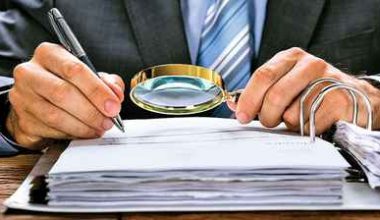Numerous items can be categorized as assets depending on the type of business, while liabilities can be satisfied in two ways: with cash, or by exchanging goods and services. A thorough understanding of your expenses will enable you to recognize all of the expenses that you can deduct, thereby lowering your taxable income and, ultimately, your tax liability. Fortunately, this post is going to provide you with the understanding you need.
Expenses Liabilities
In accounting, expenses refer to the sums of money that a company spends or costs it incurs to make money. As a result, in accounting, expenses represent the cost of doing business, which includes the total cost of all the operations that you hope will result in a profit. Your income statement lists all of these costs as deductions from gross income. So, to determine your net profit for a given period, subtract your expenses from your revenue. Accounting divides business expenses into two categories: operating expenses and non-operating expenses. Your income statement’s five primary headings for reporting expenses are as follows:
- Cost of Goods Sold
- Operating Expenses
- Financial Expenses
- Extraordinary Expenses
- Non-Operating Expenses
Understanding Expenses
Making as much money as possible is one of the top priorities for management teams of businesses. Businesses accomplish this by increasing revenues while controlling costs. However, cutting expenses too drastically may have a negative impact. For instance, cutting back on advertising can cut costs but also affect a company’s visibility and capacity to connect with potential clients.
Using either the cash basis or the accrual basis, accountants keep track of their expenses. Expenses are recorded when they are paid according to the cash basis of accounting. Contrarily, the accrual method records expenses as they are incurred.
What Are the Types of Expenses?
There are many different categories of expenses. A fixed expense does not change depending on the production level, like rent or a mortgage. Variable expenses, or those that change as production changes, are another way to classify expenses. Among them are the price of purchased goods and utilities. Additionally, you can divide expenses into operating and non-operating expenses. The former are costs directly associated with running the business, while the latter are related more indirectly.
Liabilities vs. Expenses
The operational costs a business bears to make money are expenses. Businesses list expenses on a company’s income statement along with revenue, in contrast to assets and liabilities, which are related to liabilities. In essence, you determine net income by subtracting expenses. The difference between revenue and expense is the net income. Liabilities are the commitments and debts a company owes, whereas expenses are the costs of a company’s operations. You have two options for paying expenses: you can do it right away with cash, or you can wait and incur liability.
Liabilities
A liability is something that a person or a business owes, usually a monetary sum. Liabilities are settled through the gradual transfer of financial benefits like money, goods, or services. On a balance sheet, a business lists liabilities on the right side. Accounts payable, mortgages, loans, warranties, escrow payments, bonds, and accrued expenses are some of them. In a company’s books, liabilities and assets are shown in opposition. In contrast to assets, liabilities are things you’ve borrowed or owe money on.
Liabilities and expenses shouldn’t be used synonymously. Both are found in a company’s balance sheet and income statement, respectively. Liabilities are the debts and obligations that the business is responsible for paying, whereas expenses are the costs relating to operating a business. It is possible to pay expenses immediately in cash.
How Liabilities Work
An obligation between two parties that haven’t been fulfilled or paid for generally qualifies as a liability. In the world of accounting, a financial liability is the same thing as an obligation, but it is more specifically defined by earlier business dealings, occasions, sales, the exchange of goods or services, or anything else that would bring about a financial gain in the future. In general, short-term liabilities are those that are expected to be paid off in a year or less, while long-term liabilities are those that are expected to be paid off in a year or more are non-current liabilities.
Since businesses use them to fund operations and pay for significant expansions, liabilities are an essential component of a business. Additionally, they may improve the effectiveness of business-to-business transactions.
Like accounts payable and bonds payable, the most frequent liabilities are typically the biggest. Since they are a component of ongoing short- and long-term operations, these two items are frequently found on the balance sheets of businesses.
Types of Liabilities
Organizations divide their liabilities into two groups: current and long-term.
#1. Current (Near-Term) Liabilities
Analysts prefer to see that a business can cover its short-term, cash-based obligations known as current liabilities. Payroll costs and accounts payable, which consist of money owed to vendors, are two instances of short-term liabilities. Other examples include:
- Wages Payable
The total of accrued employee wages that have not yet been paid. This liability frequently changes because most businesses pay their employees every two weeks.
- Interest Payable
Businesses, like individuals, frequently use credit to buy goods and services for short-term financing. This is the amount of interest on those upcoming purchases made with a short-term credit card.
- Dividends Payable
For businesses that have issued stock to investors and pay a dividend, this is the sum owed to shareholders following the declaration of the dividend. This liability typically arises four times a year during this two-week window, up until the dividend payment is made.
- Unearned Revenues
This is the obligation a business has to provide products and/or services at a later time after receiving advance payment. Following the delivery of the good or service, this sum will be decreased with an offset entry.
#2. Non-Current (Long-Term)
Non-current liabilities are those that are expected to be paid in a year or more and are any debt that is not short-term. Companies of all sizes borrow money from the parties who buy their bonds to finance a portion of their ongoing long-term operations. This item changes constantly as bonds are issued, reach maturity, or are recalled by the issuer. Long-term liabilities can also include obligations for rent, deferred taxes, payroll, and pensions. Other examples include:
- Warranty Liability:
Some liabilities can’t be calculated with the same accuracy as AP and must be estimated. It’s an estimate of how much time and money might be required to fix products after a warranty is accepted. Given that most automobiles have lengthy warranties that can be expensive, this is a frequent liability in the automotive sector.
- Unamortized Investment Tax Credits (UITC):
These are the remaining funds after you subtract an asset’s historical cost and depreciation. Despite being a liability, the unamortized portion of the asset represents only a rough estimate of the asset’s fair market value.
Accrued Expenses Liabilities
Because accounting periods do not always coincide with expense periods, many businesses accrue expenses but postpone payment until the following period. Expenses that you have incurred but haven’t yet paid for are called accrued expenses.
The following list of accrued expense accounts:
- Salaries payable
- Rent payable
- Utilities payable
A cost that has been incurred but not yet paid is known as an accrued expense (also known as an accrued liability). An accrued expense is typically a debit to an expense account. Your expenses go up as a result. Additionally, you can apply a credit to an account for accrued liabilities, which raises your liabilities.
Accrued expenses are sums that a business must pay in the future to cover the cost of goods and services that have already been rendered. Simply put, a business incurs costs after receiving a good or service. Although it is accounted for, this expense is paid after.
Invoices and other forms of documentation are not required for accrued costs. They are categorized as current liabilities, which means they must be settled within the next 12 months and are recorded on a company’s balance sheet. Lease payments that are due on a regular monthly basis are an illustration of an accrued expense. Even though the bill for a given month has not yet arrived, the company is aware that it will need to pay the standard amount.
What Are Liabilities in Accounting
Loans, accounts payable, mortgages, deferred revenue, bonds, warranties, and accrued expenses are all examples of liabilities. A business can compare assets and liabilities. Liabilities are debts or other obligations, whereas assets are things you own or owe money to.
Assets vs. Liabilities
Things that a business owns are called assets. It could consist of physical things like structures, machinery, and equipment as well as intangible things like interest due, accounts receivable, patents, or intellectual property. A business can calculate the remaining balance, or owner’s or stockholders’ equity, by deducting a company’s liabilities from its assets. Assets are things you own or owe money to, whereas liabilities are debts or other obligations.
Assets are the things that a company owns or that it is owed money for, and they can be both tangible things like houses, machines, and equipment as well as intangible things like unpaid bills, interest, patents, or intellectual property. A company’s owner’s equity or stockholders’ equity is calculated by deducting its liabilities from its assets. The following sentence describes this connection:
Assets − Liabilities = Owner’s Equity
A company’s assets are any possessions that have the potential to generate future financial gain. Liabilities are the sum of all your obligations to others. Assets essentially improve your financial situation, whereas liabilities worsen it.
Liabilities lower the value of your company and its equity while assets increase those two metrics. Your company’s financial health is stronger the more assets it has compared to liabilities. However, if you find that your liabilities exceed your assets, you might be in danger of going out of business.
Are Expenses Liabilities or Equity
Expenses are the monthly payments made by your business to fund operations. The obligations and debts owed to other people are known as liabilities. While expenses are in some ways a subset of liabilities, they are used in different ways to monitor the financial health of your company. Liabilities are the commitments and debts a company owes, whereas expenses are the costs of a company’s operations. Spending reduces assets, increases liabilities, and decreases equity instead of being an asset, liability, or equity.
An accounting balance sheet lists liabilities. An income statement, also known as a profit-and-loss statement, lists operating expenses.
What Is an Example of a Liability and an Expense?
An expense is the utilities for your shop. It is a liability to have a mortgage on your store. An accounting balance sheet lists liabilities. An income statement, also known as a profit-and-loss statement, lists operating expenses. Rent, utilities, pay, salary, maintenance, depreciation, insurance, and the cost of goods sold are a few examples of expenses. Expenses are typically regular payments required to run a business.
Are Expenses Payable Liabilities?
These expenses, which are typically current liabilities and are also known as accrued liabilities, are recorded on a company’s balance sheet. A revision is made and accrued liabilities are recorded on the balance sheet after each accounting period. The delivery of goods and services for which a bill has not yet been issued is recorded with any necessary adjustments. Examples include wages that are owed to employees but have not yet been paid, the consumption of goods and services without the receipt of an invoice, etc.
What Are Assets Liabilities and Expenses?
Assets are possessions or resources that you own or possess with the expectation of reaping future benefits. Numerous items can be categorized as assets depending on the type of business. Examples. Cash inventory, receivables, machinery, a building, etc.
Liabilities include debt and other business obligations that a company owes to a non-owner. Since liabilities are obligations we will have to fulfill in the future, it is simple to spot them because the account will frequently end in the word “payable.” Examples include accounts payable, wages due, unearned income, sales taxes due, etc.
Expenses are costs to the business and represent cash outflow. These costs represent all operating expenses and are used to produce revenue, such as cost of goods sold, salary costs, utility costs, rent costs, etc.
What Are the 3 Types of Liabilities?
Liabilities can be classified as current, non-current, or contingent. Liabilities that are contingent on future events fall under a different category. Depending on how a hazy future event plays out, they are potential liabilities that might or might not materialize.
Liabilities that become due more than a year from now are referred to as non-current (long-term) liabilities. It is crucial that short-term obligations, such as short-term loans or the current portion of long-term debt, are not included in the non-current liabilities.
The term “current” refers to obligations with a one-year maturity date. These mainly happen as a result of typical business operations. These financial commitments should be managed to take into account the company’s liquidity due to their short-term nature.
What Are Examples of Expenses vs Assets?
Purchases made by a business to carry out its operations are both assets and expenses. They differ from one another in terms of how you record them, what they’re used for, and how much they cost. The income, or profit and loss, statement is where accountants keep track of expenses. This compares a company’s monthly or quarterly profits to its expenses.
Is Income a Liability or an Asset?
A company’s income is the sum of money it consistently brings in from sales. The cash that a company already has on hand is an asset. Additionally, advance income is viewed as a liability.
Conclusion
A liability is an obligation that an individual or organization has, usually a financial one. Liabilities are eventually settled through the exchange of financial benefits like money, goods, or services.
Loans, accounts payable, mortgages, deferred revenue, bonds, warranties, and accrued expenses are just a few examples of the debts that are included in the category of liabilities, which are shown on the balance sheet’s right side. Because they are used to fund operations and pay for significant expansions, liabilities are an essential component of a business. Additionally, they may improve the effectiveness of business-to-business transactions.
The operational costs a business bears to make money are expenses. You could sum it up by saying that the cost of obtaining something. A business’s operating expenses are costs that the company must pay. Payroll costs, maintenance costs, rent costs, and depreciation are all expenses. To calculate profits, you subtract expenses from revenue. Certain costs incurred by businesses may be written off as tax deductions to reduce their tax liability and increase profits.
Related Articles
- LIABILITIES: Meaning & What You Should Know
- Accrual: A Detailed Guide
- WHAT ARE ASSETS AND LIABILITIES: Definition, Differences and Examples
- SMALL BUSINESS ACCOUNTING SOFTWARE: Meaning, Best Software & Degree






